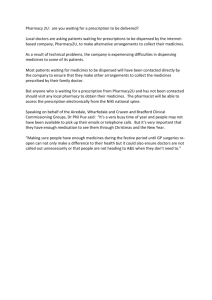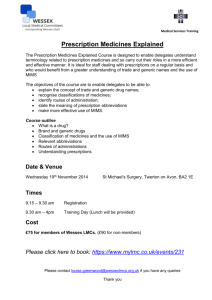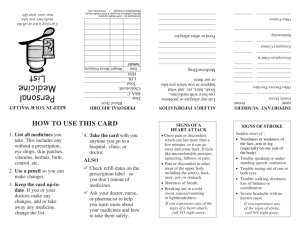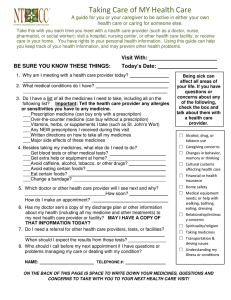Good Dispensing Practice: A Guide to Safe Medication Handling
advertisement
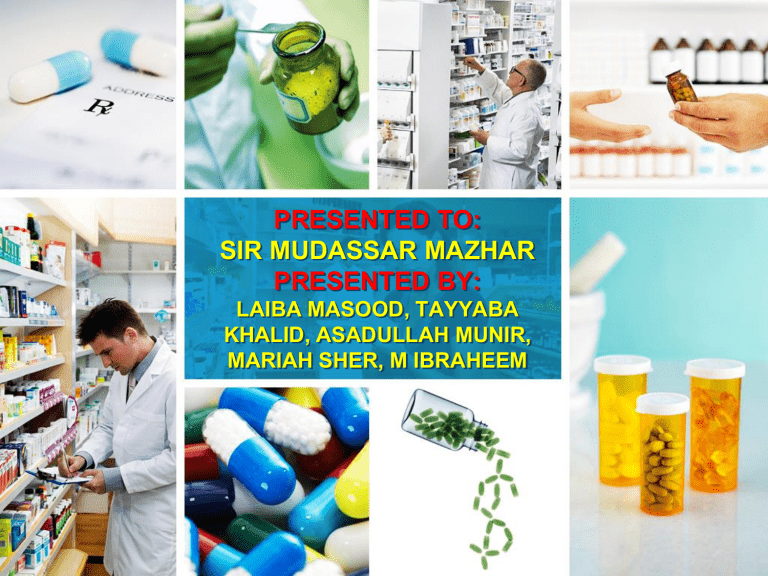
PRESENTED TO: SIR MUDASSAR MAZHAR PRESENTED BY: LAIBA MASOOD, TAYYABA KHALID, ASADULLAH MUNIR, MARIAH SHER, M IBRAHEEM GOOD DISPENSING PRACTICE • Dispensing refers to the process of preparing and supplying medicines to a named person together with clear instructions, advice and counselling where necessary on the use of those medicines. It involves the correct interpretation of the order for prescribed medicines and accurate preparation and labelling of medicines for use by the patient. The dispensing process includes all activities that occur between the time the prescription or request for medicine is presented up to the time the medicines or other prescribed items are issued to the patient • Good Dispensing Practice ensures that the right medicines of desired quality are delivered correctly to the right patient with the right dose, strength, frequency, dosage form and quantity, together with clear instructions, both written and verbal and with appropriate packaging suitable for maintaining the quality and efficacy of the medicine GDP The dispensing environment includes: Qualified / trained staff Appropriate physical surroundings Adequate shelving and storage area Proper work surfaces Suitable equipment Necessary packaging materials GDP • Responsibility for the accuracy and quality of the medicines supplied lies on the persons overseeing the dispensing process. It is important that the staff dispensing medicines are trained and equipped with the technical knowledge and the skills necessary to dispense the range of medicines prescribed and to communicate effectively with patients/ caregivers SCOPE Applicable to Group B and C of Poisons Lists. Medicines for human use only. Applicable to public healthcare facilities. Applicable to the licensed private healthcare facilities (clinics, hospitals, community pharmacies, dental clinics). DISPENSING PROCESS • • Adherence to good dispensing procedures is vital in ensuring that medicines are dispensed correctly and any potential/ real errors which may occur during the dispensing process are detected and rectified before medicines reach the patient Who should be involved in the process of dispensing?? • Screening of Prescription: Healthcare professional (Registered medical practitioner/ registered dentist/ pharmacist). • Preparation of Medicines: Pharmacist, registered medical practitioner or a person under immediate supervision of a pharmacist/ medical practitioner. • Supplying the Medicines: Registered medical practitioner, registered dentist or pharmacist. • Counselling: By healthcare professional. Prescription and its Parts It is an order written by a physician, dentist, veterinary medical officer or any other registered medical practitioner to a pharmacist to compound and dispense a specific medication for the patient. Parts of prescription: i. Date ii. Name , Age, Gender,& Address of patient iii. Superscription iv. Inscription v. Subscription vi. Signatura vii. Signature, date and registration number of physician Screening • Only a pharmacist can receive the prescription. The prescription should be written legibly or printed. • On receiving a prescription, it should be screened and validated to ensure that it is for the correct patient and it complies with the requirements. Patient Details Prescription Details Name. Address. Identification number. Drug regimen (name of drug, dose, frequency, administration and duration) Doctor’s signature, stamp, and registration number. Doctor’s name and address. Date of prescribing. • Names of medicines prescribed should be written in generic name. • Abbreviations should not be used. • If a patient must be given a particular brand, it should be indicated on the prescription. • Age of the patient and body weight should be stated on prescriptions for children under 12 years of age. Interpreting the Prescription Order: The person receiving the prescription should check for: • Dose, frequency and duration. • Drug interactions, medicine duplication, polypharmacy, inappropriate drug therapy, contra-indications & allergies. • Unusual usage and suspected drug misuse or abuse. • For partial medicine supply, ensure that the second or subsequent supply does not exceed the quantity for the duration prescribed. Handling the Prescription which Requires Clarification: Careful, examination of the prescription should be made only behind the counter. If an incomplete prescription or one which requires further clarification is received, contact the prescriber. If the prescriber can be contacted and is available on site, arrange for the incomplete/missing details to be inserted on the prescription by the prescriber. If the prescriber is not available to amend the prescription himself/herself, authorization to make the change may be obtained verbally through the phone. • The amendments should be documented on the prescription and endorsed with PRESCRIBER CONTACTED dated . • If the prescriber cannot be contacted, patient should be informed and the prescription must be sent back to the prescriber with information on the clarification/action needed. • Prescriber should document any changes made to the patient’s medical record. Handling Prescriptions in a Stock Out Situation: • Stock-out is defined as a situation where the prescribed medicine is not available at the pharmacy when a prescription is being processed. This may be due to the medicine being temporarily out of stock at that time or the pharmacy does not keep stock of that particular medicine. If such situation occurs: • If the medicine cannot be substituted with another medicine that is available, inform the patient. • If the patient agrees for it to be supplied at a later time, arrange to get stock. • If the patient requires the medicine urgently, the pharmacist communicate with the prescriber to discuss if the prescribed medicine can be substituted with another medicine which is readily available. • Any substitution of medicine must be approved by the prescriber and documented on the prescription. • Prescriber should document these changes in the patient’s medical record. Preparing the Medicine 1.Selecting the Medicine: When selecting the medicine to be dispensed, prevent any medication errors by establishing an appropriate system to ensure that the correct medicine is selected, especially if there are medicines with similar names and packaging. Pick the medicine by reading the label at least twice and cross-checking the medicine name and strength against the prescription. If a barcode system is available, it should be used to enable correct and accurate selection of the medicine. Check the expiry date of dispensed medicines to ensure that they remain unexpired for the duration of the supply course. Medicines should be dispensed in original packaging as far as possible. Tablets/capsules should not be removed from the strip/blister when dispensing. Bulk loose packs for supply are not encouraged. Avoid direct contact with the hand if loose packs are to be used. Medicines which need to be packed such as loose capsules/tablets should be packed into a clean, dry container, such as a bottle or plastic envelope which will not compromise the quality of the product after dispensing. 2. Extemporaneous Preparation/ Compounding: • Extemporaneous preparations should only be prepared if there is no equivalent product available commercially and the product has to be compounded based on the patient’s needs. • For compounding of psychotropic substance, no person shall dispense, compound or mix any psychotropic substance with any other substance, whether a psychotropic substance or not, for the purpose of it being used for medical, dental or animal treatment unless he is a licensed pharmacist; or a pharmacist in the public service. • However, a pharmacy assistant or medical assistant employed in any government facility may also compound or mix any psychotropic substance for the purpose of medical treatment upon prescription prescribed by a registered medical practitioner or registered dentist. Compounding of extemporaneous preparation should only be done on a patient- specific basis. Ingredients used for compounding are sourced from recognized pharmaceutical supplies. Ensure that the preparation is prepared according to formulation from a reputable reference. There should be worksheets for the compounding which should be checked by a staff member knowledgeable in compounding and counter-checked by a pharmacist/ another qualified staff member / doctor. Staff involved in compounding should be competent to perform this task under the supervision of pharmacist or registered medical practitioner. Availability of necessary facilities and equipment which are maintained in good order. • In a situation where hazardous substance, such as cytotoxic medicines is to be handled, staff should use appropriate Personal Protective Equipment (PPE) and follow the specific procedures. Once the preparation is ready, label the product with necessary particulars including expiry date/ special requirements for safe handling and storage. Keep worksheets or record books for a minimum of two years. The document should contain information as below: Formula. Ingredients and quantity used. Manufacturer, batch number and expiry date of ingredients used. Patient & prescription details. Names of persons involved in preparing and counterchecking the product. Date of compounding. 1. Labelling: Every medicine containing any scheduled poison sold or supplied must be prepared and labelled by or under the immediate personal supervision of the pharmacist or All dispensed medicines should be labelled according to the requirement stated by law. It is advisable for labels to be printed. If handwritten, it should be neat and legible with clear instructions on use. Label Should Contain Followings: Name, address, and contact number of company. Name of medicines (generic and/or trade names). Dosage form with the strength and quantity per unit dosage form: mg/ml of liquid, mg/g for semi-solid preparations. Directions for use: dose, frequency and duration (if necessary). Expiry date (especially if dispensed medicine is not in its original packing. Manufacturing date. Controlled Medicine should be labelled for all controlled medicines. Batch number. Medicines for external use should be dispensed in suitable containers and should be labelled conspicuously with the words “Not to be Taken” or “For External Use Only”. Special precautionary labels should be used where necessary (e.g., “Complete the course” for antibiotics, and “May cause drowsiness” for sedating drugs). • Whenever possible, always dispense the medicine in its original packaging so that patients will have access to the product information. • If a medicine is not dispensed in its original packaging and it is not possible to include all the necessary information on the label, it should be written/printed separately and dispensed together with the medicine. Patient information leaflet (PIL) should be provided, where available. 2. Checking: • Check the prescription and the filled medicines to ensure that the filled medicines correlate with the prescription. 3. Counter-Checking: Counter-checking should be done by a second person, other than the staff who did the previous filling and labelling tasks. Check all the medicines prepared for dispensing against the prescription. Once the counter-checking is done, the person performing prescription. this task should initial on the 4. Recording: • Proper record keeping is an essential part of dispensing as it facilitates good management and monitoring of services provided. Such records can be used to verify the stocks used in dispensing, and will be required if a need arises to trace patients dispensed with a particular medicine. All sale or supply of poisons in private facilities must be recorded in a “Prescription Book” on the day of the sale or supply. The following particulars need to be recorded: Date of sale or supply and the serial number of the entry of the prescription. Generic name of drug and the quantity supplied. Name and address of the patient. All sale or supply of Psychotropic Substances must be recorded in a “Prescription Register for Psychotropic Substances” on the day of the sale or supply. The following particulars need to be recorded: Date and serial number of sale or supply. Name and strength of the psychotropic substance and the quantity sold/ supplied. Name, contact number and address of the patient. The balance stock should be updated for each supply of the psychotropic substance in possession. The required entry must be in chronological order with respect to the previous entries in the register. Each strength or type of psychotropic substance must be recorded in a separate register or a separate part of the register. 5. Issuing Medicine to the Patient: • Issuing or supply of medicine should only be done by registered medical practitioner or a pharmacist. When dispensing the medicines, ensure the 5Rs: Right Patient. Right Medicine. Right Dose. Right Route. Right Time. a) Check the name and ID to verify the right patient. b) Medicines supplied for a person under 18 years of age is for the purpose of his medical treatment only. c) Ask about allergies or known adverse drug reactions (ADR). d) Give clear instructions and proper advice on how to take/ use the medicines dispensed. e) Ensure the patient is made aware if there are special requirements during transportation, proper storage conditions and usage requirements for the medicines. f. Compliance aids (e.g. measuring spoon or syringe) for the appropriate dose should be provided, if required. Every effort must be made to ensure that the recipient understands the information/instructions and advice provided. Advise patients to inform the clinic/pharmacy should they encounter any adverse drug reactions (ADRs) when taking the dispensed medicines. Supply of medicines based on prescription, the name of the person who dispensed the medicines, address and the date of supply should be written on the prescription above the doctor’s signature as a form of endorsement. Dispensing Flowcharts Medication Erros: Prescribing Errors: • WRONG DRUG OF CHOICE • WRONG DOSE • WRONG UNITS • WRONG FREQUENCY • WRONG DURATION Dispensing Errors: 1. Wrong assumption of prescription reading 2. Wrong dispensing of drugs/dose/dosage form/quantity 3. Look alike and sound alike drugs 4. Fail to give proper information to patients 5. Time factor Patient Counseling • Name of medication (brand/generic), dose, dosage form, schedule • List precautions: e.g., use sunscreen, avoid milk • How to administer (IV, IM etc.)(before/after food) • Special directions (storage, dilution) Life Style Modification: • Do regular checkups – BP, Blood sugar level, ECG and Lipid profile • Have a walking at least for 30min/day • Take more of fruits. • Reduce salt intake • Avoid fat containing food Non-Prescription Medicines: When non-prescription medicine is supplied, ensure that: a) Sufficient information is gathered from the client to assess nature of problems, symptoms and past medical / medication history. b) Select an appropriate medicine. c) Label for the medicines prepared. d) Checking of the medicine before issuing it. e) Recording done. f) Medicine is supplied with proper instruction.
